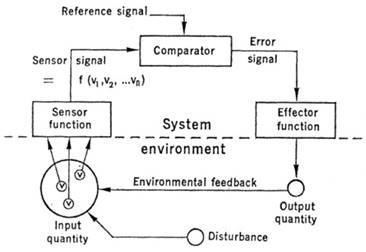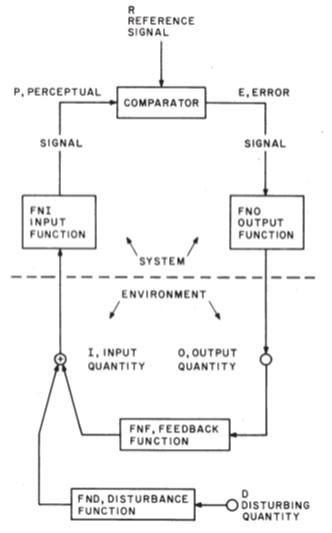[From Bruce Abbott (2017.02.28.1115 EST)]
Rick Marken (2017.02.27.2140) –
Bruce Abbott (2017.02.27.1900 EST)
BA: …The equation given for the instantaneous value, given in equation 4, provides a clearer picture of how qi is determined on each passage around the loop:
qi = keqo + kdd
BA: This shows that the current value of qi is a joint function of feedback plus disturbance. It is the value of the environmental variable after it has been affected by feedback and disturbance. The output and disturbance quantities are not the environmental v’s that jointly determine a perceptual signal that is a complex function of these v’s.
RM: But qo and d are environmental variables. So the equation implies that the controlled perceptual variable, p, which from the observer’s perspective is q.i, is just a weighted sum of these two variables.
BA: In one definition (where Qi represents the environmental equivalent of the controlled perception), Qi is defined according to what environmental variables affect the input function. It is not defined by Qo or d. As issue is what defines Qi, not what inputs affect its value. You must know that. Therefore I can only conclude that your objective in introducing this red herring is to obfuscate and confuse the issue.
RM: So depending on the level of the hierarchy we are talking about, q.i can represent a simple function of physical variables, like q.i = kv. Or a more complex one, like q.i = int(x=1 to infinity)(A((X-N/r.p)/N/r.p*)) (the function used to determine the controlled variable, q.i, in the "Feedback Model paper, p. 52, LCS I).
RM: I think Bill took it for granted that people would understand that q.i was a variable that represented a possibly very complex function of environmental variables and , moreover, that they would understand that q.i would not be computed by the environment itself… Alas, it appears that this was one of the few times Bill was wrong.
BA: No, Bill wasn’t wrong – noobody in this debate believes that the environment does that.
RM: Do you believe that q.i is an actual entity in the environment, an entity like distance or area or probability? If so, then it would seem that you would have to believe, perhaps unknowingly, that q.i is calculated by the environment.
BA: I don’t believe that the environment calculates anything. A soap bubble is spherical because molecular forces tend to contract the soap film until the pressure inside the bubble becomes strong enough to resist any further contraction. I could use mathematical computations to model this process, but that does not mean I believe that the soap bubble is doing any calculating. That said, I do believe that there are actual entities in the environment, like distance or area or inter-shock interval. As an observer I might represent these mathematically in a model, but that is a very different thing from believing that the environment is computing these things.
BA: The complex equation cited above gives the probability of shock delivery as a function of the average rate of lever-pressing. This equation combines the effect of disturbance (shock probability in the absence of responding) and the environmental feedback function (the reduction in shock probability as a function or average response rate). As in your previous example, it is not an equation combining the effects of several environmental input variables (v’s) to represent the environmental equivalent of the controlled variable. It is an equation representing how disturbance and feedback affect that variable. You are using the wrong equation to make your case!
RM: The complex equation cited above – int(x=1 to infinity)(A((X-N/r.p*)/N/r.p*)) – is, as you say, a calculation of the probability of shock, the perceptual variable that the organism is presumed to be controlling. This calculation (or something similar) cannot be done by the environment; the shocks are just something that happens or doesn’t. So the equation is an approximation to the perceptual function that produces the perceptual variable p.s, the probability of a shock. The calculation of p.s that Bill did for the different shock intervals are the values of q.i, which are the values of p.s from the observer’s (Bill’s) perspective.
BA: That’s not the issue. The issue is that the equation you cited gives us the effects of disturbance and output on Qi; it does not define Qi.  It’s the same red herring as in your previous example.
BA: Bill’s analytical solution involved computing a shock density distribution as a function average response rate. This is a function of the environmental contingency set up by the experimenter. You are mistaking the formula for this analytical solution for the actual way in which shock rate is determined by the contingency set up by the experimenter between lever-pressing and shock delivery. The actual arrangement used by the apparatus to determine when a shock would be delivered is really quite simple: If the required number of responses has not been completed before the interval elapses, deliver a shock, reset the response counter to zero, and start timing a new interval. No complex equations are being “solved� by the environment.
RM: Yes, the apparatus determines whether or not a shock is delivered based on the number of responses in a time interval. This and the rat’s response rate determine the probability (or rate) of shock. But in order to control the probability of getting shocked the rat has to perceive it; Bill’s equation is one version (probably more complex than it needs to be) of a calculation that will produce a perception of that probability; and at the same time the calculation produces a measure of p.s for the observer (Bill) which is q.i.
No, Bill’s formula provides a mathematical representation of the environmental feedback function: how the average rate of lever-pressing affects the probability of shock It has nothing to do with the rat’s perception of that probability.
BA: What the rat actually experiences is a series of irregularly spaced shocks. A perceptual input function that gives rise to a perception of shock probability would have to do something equivalent to computing the average shock rate over time, probably by means of a leaky integration of the inter-shock intervals. (This would weight the more recent intervals more heavily in determining current perceived shock probability.)
RM: Yes, that would have been a much simpler way to compute it; and it would have been nice if the observer (Verhave) had computed shock probability that way. Then Bill could have used Verhave’s observed measures of shock probability (q.i) as estimates of the rat’s perception of shock probability, p.s, and the whole exercise would have been much clearer. But, of course, Verhave had no idea that shock probability might be a controlled variable so he didn’t measure it at all. That’s why Bill had to use these fancy equations to calculate q.i and p.s.
BA: I did not present a “much simpler way to compute� the rat’s perception of shock probability, because Bill’s formula does not present the input function, it presents the environmental feedback function. Geez, Rick, this is control theory 101. I’m surprised that you are so confused about it.
RM: Besides the absurdity of thinking that the function that defines q.i is computed in the environment,
BA: I have never made that claim; in fact I have been careful to acknowledge that the environmental equivalent of p is determined by the input function, and that therefore there may not be a single environmental variable that corresponds to qi.
RM: It’s great that you acknowledge that the environmental equivalent of p is determined by the input function. That is absolutely correct!! But why does that mean that there may not be a single environmental variable that corresponds to qi?
BA: That the environmental equivalent of p is determined by the input function is the position I have always taken; I did not just “acknowledge� it as a result of your prompting. If you missed that fact then perhaps you should read more carefully. I don’t see how you can criticize someone’s position with any authority if you have not even bothered to understand that that position is. Or are you purposefully misrepresenting it in order to score debate points?
BA: As for my statement that “there may not be a single environmental variable that corresponds to qi,� I might have been clearer there.  In some cases there is a direct correspondence between a perception and a single environmental variable qi. In other cases p depends on more than one environmental variable, in which case there is no single entity in the environment corresponding to qi. Instead, qi represents a specific combination of environmental variables as determined by the input function. (Here I am defining qi and the environmental equivalent of p. I have previously demonstrated that Bill Powers defined qi this way on some occasions and as the individual environmental variables of which p is a function on other occasions.)
RM: the idea of thinking that the perceptual signal is a function of – rather than equivalent to – q.i, suggests that Powers was proposing that the environment (not the living control system itself) has computed a hierarchy of q.i’s, from sensation q.i’s to system concept q.i’s, that are out there to be detected by our perceptual systems. That would mean that when we study the hierarchy of control we are studying how the environment arranges itself into things to be perceived rather than the perceptual functions of organisms that organize (construct) the environments into the perceptions in which we carry out our purposes. I’m sticking with the idea that Bill was proposing a hierarchy of perceptual functions, not a hierarchy of environmental variables of varying degrees of complexity.
BA: But nobody has made that claim, except evidently in your imagination.
RM: Yes, it is in my imagination. I imagined that it is the only way that you can claim that the perceptual variable is a function of qi.
BA: You didn’t need to resort to imagination as I have presented my position clearly enough in previous posts. All you had to do was read them and carefully follow the reasoning.  Why don’t you give it a try?
RM: If this is not the case, please write the pseudo code for a system that controls, say, the area of a circle and show me how q.i fits into that control loop. That would really help me understand what you’re talking about.
BA:Â OK, here it is:Â
p = f(qi), where f is the perceptual input function, p is the perception of the circle’s area, and qi is the actual area of the circle as objectively measured.
BA:  I really don’t need any more code than that. I don’t need to show how one might adjust or control that area, as the perceptual function works the same whether the circle’s area is being controlled or not. Note that p = f(qi), not p = qi as you have previously claimed.
Bruce


